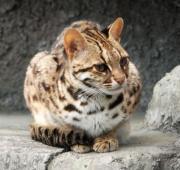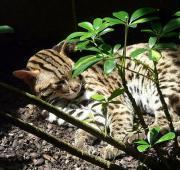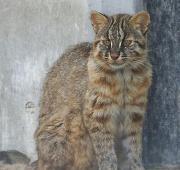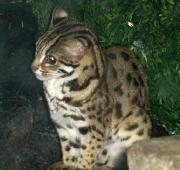 The leopard cat is a small species of wild cat, native to south-east Asia and parts of the Indian subcontinent. There are eleven different species of leopard cat in the Asian jungles and as the name suggests, the fur of the leopard cat has the the similar spotted pattern to that of a leopard.
The leopard cat is a small species of wild cat, native to south-east Asia and parts of the Indian subcontinent. There are eleven different species of leopard cat in the Asian jungles and as the name suggests, the fur of the leopard cat has the the similar spotted pattern to that of a leopard. The leopard cat is found in a variety of different habitats including tropical jungles, woodlands, scrubland and semi-desert regions that are relatively close to water. The leopard cat is widely distributed and can be found inhabiting parts of Indonesia, Philippines, Borneo, Malaysia, Singapore, Thailand, Myanmar, Laos, Cambodia, China, Taiwan, Korea, Bangladesh, India, and Pakistan.
The leopard cat is found in a variety of different habitats including tropical jungles, woodlands, scrubland and semi-desert regions that are relatively close to water. The leopard cat is widely distributed and can be found inhabiting parts of Indonesia, Philippines, Borneo, Malaysia, Singapore, Thailand, Myanmar, Laos, Cambodia, China, Taiwan, Korea, Bangladesh, India, and Pakistan.


Like other feline species, the leopard cat is a carnivorous animal solely hunting and eating other animals in order to survive. The leopard cat primarily preys on small animals such as rodents, birds, frogs and lizards but will also snack on insects and eggs from nests in the trees.
Despite it's relatively small size, the leopard cat is nonetheless a dominant predator within it's environment and therefore there are few animals that prey on it. The main predators of the leopard cat are larger wild cats such as tigers and leopards, along with wild dogs and the occasional large snake.
Leopard cats only really come together to mate which can happen at any time of year. After a gestation period that lasts from 8 to 10 weeks, the female leopard cat gives birth to a litter of between 2 and 4 kittens. Leopard cat kittens are blind when they are first born and usually open their eyes within the first two weeks. The leopard cat kittens are thought to be raised by both parents until they are about 10 months old.
Today, although not under immediate threat from extinction, the world's leopard cat populations are declining. The primary cause for the decline in leopard cat is numbers is habitat loss caused by deforestation in their native regions.

